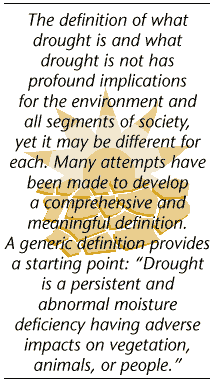Farmers who do not have
irrigation systems, for example, take a risk when they plant crops,
assuming that there will be enough rain throughout the growing season to
produce a successful harvest. For the most part, the risk is based on
how often there has been enough rain in the past. Long-term predictions
of precipitation are still too unreliable to reduce that risk
significantly.
At our hearings across
the country, we were told of several gaps among existing programs and
the needs of farmers and ranchers who do not rely on irrigation:
 |
Farmers
and ranchers may lack information about local climate and drought
conditions and predictions. Many also lack basic soil information;
a soil survey remains to be completed for approximately 10% of the
country. These deficiencies can limit a farmerís or rancherís
ability to make timely decisions on the types of crops to plant or
whether to reduce stocking rates on the range.
|
 |
Many
farmers and ranchers do not have access to available information
and other resources to develop and implement a water
conservation/drought plan. Less than 10% of farmers and ranchers
are receiving technical assistance to help them develop and
implement such plans, and an even smaller number are receiving
cost-share assistance for these plans.
|
 |
Federal
crop insurance covers only the "primary" crops grown and
does not extend to other crops or to livestock. We learned that
during drought the price of transporting feed after stored
supplies are used up is prohibitive in many cases, as is the price
of transporting water to livestock where ponds have gone dry. |
We heard too that when
drought affects the incomes of farmers and ranchers and the owners of
water-dependent businesses, it also affects the incomes of nearby local
businesses. Such economic impacts may extend further to nearby cities.
Return to Table of Contents | (Next
Page) |
 |

